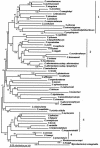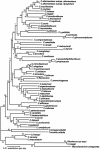rpoB gene sequencing for identification of Corynebacterium species
- PMID: 15364970
- PMCID: PMC516356
- DOI: 10.1128/JCM.42.9.3925-3931.2004
rpoB gene sequencing for identification of Corynebacterium species
Abstract
The genus Corynebacterium is a heterogeneous group of species comprising human and animal pathogens and environmental bacteria. It is defined on the basis of several phenotypic characters and the results of DNA-DNA relatedness and, more recently, 16S rRNA gene sequencing. However, the 16S rRNA gene is not polymorphic enough to ensure reliable phylogenetic studies and needs to be completely sequenced for accurate identification. The almost complete rpoB sequences of 56 Corynebacterium species were determined by both PCR and genome walking methods. In all cases the percent similarities between different species were lower than those observed by 16S rRNA gene sequencing, even for those species with degrees of high similarity. Several clusters supported by high bootstrap values were identified. In order to propose a method for strain identification which does not require sequencing of the complete rpoB sequence (approximately 3,500 bp), we identified an area with a high degree of polymorphism, bordered by conserved sequences that can be used as universal primers for PCR amplification and sequencing. The sequence of this fragment (434 to 452 bp) allows accurate species identification and may be used in the future for routine sequence-based identification of Corynebacterium species.
Figures



Similar articles
-
Characterization of some bacterial strains isolated from animal clinical materials and identified as Corynebacterium xerosis by molecular biological techniques.J Clin Microbiol. 2010 Sep;48(9):3138-45. doi: 10.1128/JCM.02373-09. Epub 2010 Jul 21. J Clin Microbiol. 2010. PMID: 20660219 Free PMC article.
-
Comparison between rpoB and 16S rRNA gene sequencing for molecular identification of 168 clinical isolates of Corynebacterium.J Clin Microbiol. 2005 Apr;43(4):1934-6. doi: 10.1128/JCM.43.4.1934-1936.2005. J Clin Microbiol. 2005. PMID: 15815024 Free PMC article.
-
Usefulness of rpoB gene sequencing for identification of Afipia and Bosea species, including a strategy for choosing discriminative partial sequences.Appl Environ Microbiol. 2003 Nov;69(11):6740-9. doi: 10.1128/AEM.69.11.6740-6749.2003. Appl Environ Microbiol. 2003. PMID: 14602635 Free PMC article.
-
Dissection of phylogenetic relationships among 19 rapidly growing Mycobacterium species by 16S rRNA, hsp65, sodA, recA and rpoB gene sequencing.Int J Syst Evol Microbiol. 2004 Nov;54(Pt 6):2095-2105. doi: 10.1099/ijs.0.63094-0. Int J Syst Evol Microbiol. 2004. PMID: 15545441
-
Efficient differentiation of Corynebacterium striatum, Corynebacterium amycolatum and Corynebacterium xerosis clinical isolates by multiplex PCR using novel species-specific primers.J Microbiol Methods. 2017 Nov;142:33-35. doi: 10.1016/j.mimet.2017.09.002. Epub 2017 Sep 6. J Microbiol Methods. 2017. PMID: 28888870
Cited by
-
Characterization of some bacterial strains isolated from animal clinical materials and identified as Corynebacterium xerosis by molecular biological techniques.J Clin Microbiol. 2010 Sep;48(9):3138-45. doi: 10.1128/JCM.02373-09. Epub 2010 Jul 21. J Clin Microbiol. 2010. PMID: 20660219 Free PMC article.
-
Evidence for reductive genome evolution and lateral acquisition of virulence functions in two Corynebacterium pseudotuberculosis strains.PLoS One. 2011 Apr 18;6(4):e18551. doi: 10.1371/journal.pone.0018551. PLoS One. 2011. PMID: 21533164 Free PMC article.
-
Draft genome and description of Corynebacterium haemomassiliense strain Marseille-Q3615T sp. nov., a new bacterium isolated from a 59-year-old man with chronic obstructive pulmonary disease symptoms.New Microbes New Infect. 2020 Oct 28;38:100801. doi: 10.1016/j.nmni.2020.100801. eCollection 2020 Nov. New Microbes New Infect. 2020. PMID: 33251018 Free PMC article.
-
Multiplex polymerase chain reaction to identify and determine the toxigenicity of Corynebacterium spp with zoonotic potential and an overview of human and animal infections.Mem Inst Oswaldo Cruz. 2013 May;108(3):272-9. doi: 10.1590/S0074-02762013000300003. Mem Inst Oswaldo Cruz. 2013. PMID: 23778659 Free PMC article.
-
Corynebacterium pseudodiphtheriticum as etiologic agent of human infections worldwide: a review of case reports within the last 40 years (1983-2023).Braz J Microbiol. 2025 Sep;56(3):1929-1947. doi: 10.1007/s42770-025-01739-1. Epub 2025 Jul 16. Braz J Microbiol. 2025. PMID: 40668499 Review.
References
-
- Collins, M. D., R. A. Burton, and D. Jones. 1998. Corynebacterium amycolatum sp. nov., a new mycolic acid-less Corynebacterium species from human skin. FEMS Microbiol. Lett. 49:349-352.
-
- Collins, M. D., E. Falsen, E. Akervall, B. Sjödén, and N. Alvarez. 1998. Characterization of a novel non-mycolic acid containing Corynebacterium: description of Corynebacterium kroppenstedtii sp. nov. Int. J. Syst. Bacteriol. 48:1449-1454. - PubMed
-
- Felsenstein, J. 1989. PHYLIP—phylogeny inference package (version 3.2). Cladistics 5:164-166.
-
- Funke, G., and K. A. Bernard. 1999. Coryneform gram-positive rods, p. 319-345. In P. R. Murray, E. J. Baron, M. A. Pfaller, F. C. Tenover, and R. H. Yolken (ed.), Manual of clinical microbiology, 7th ed. American Society for Microbiology, Washington D.C.
MeSH terms
Substances
LinkOut - more resources
Full Text Sources
Other Literature Sources
Molecular Biology Databases

